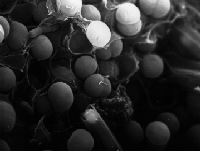Microcystis aeruginosa
Microcystis aeruginosa is a single-celled, colonial cyanobacterium
which often forms blooms in the warmer months of the year both in the Southern
and Northern hemispheres. It is common in eutrophic waters and field trips to
local sewage treatment plants and settling ponds usually yield a good sample
of Microcystis. and other cyanobacteria. The bloom forming habit of
this organism is a primary cause of many animal poisonings due to the
accumulation of large amounts of Microcystis. "scum
" on the shores of
lakes, ponds and rivers. At the mercy of the prevailing winds, these scums can
drift from shore to shore and are usually found on the windward side of a body
of water, quite often making drinking water inaccessible for many animals.
Ingestion of this concentrated material (which can often be several inches
thick) usually leads to some symptoms of toxicty.

A Scanning Electon Micrograph of Microcystis aeruginosa .
Kindly provided by Dr Colin Carbis.
This archival page is no longer updated. The current equivalent page is here.

